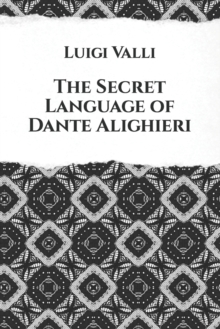From that long investigation of mine the conclusions that I summarize and explain in this book arose and which, I will say immediately, are the following: It is true that the poetry of the "Fedeli d'Amore", especially that of Dante and his most immediate predecessors, of the his contemporaries and his successors, is written in a secret jargon for which at least thirty words (Rossetti had already pointed out some, deceiving himself about others) constantly have, in addition to the apparent meaning concerning love matter, a second and sometimes also a third conventional meaning, concerning the ideas of an initiatory doctrine and the life of a group of initiates.
These words are precisely those that with exasperating monotony fill the lines of these "Faithful", very often presenting nonsense in the literal plane, namely: love, madonna, death, life, women, madness and madness, cold, gaiety, gravity, boredom, nature, weep, stone, rose, flower, source, greeting, wild, shame and others of less frequent use.
It is true that all the women of the dolce stil novo are in reality one woman and that is the holy Wisdom, which in the special use of the dolce stil novo conventionally takes a different name for each different lover and is called Beatrice for Dante, Giovanna for Guido Cavalcanti, Lagia for Lapo Gianni, Selvaggia for Cino and so on. And since, as I said above, the doctrine cultivated by a sect and the sect itself are confused under the same designation, these women also serve to designate the sect of the "Fedeli d'Amore".
Dante's Vita Nuova is all written in this jargon: it is all symbolic from the first to the last word and concerns the initiatory life of Dante and his relations not with the wife of Simone de 'Bardi, but with the Holy Wisdom and with the group that cultivated it.
Therefore the Beatrice of the New Life does not differ substantially from the one who appears triumphant on the chariot of the Church in the apocalyptic vision of the Divine Comedy.
The darkest poems of the "Fedeli d'Amore" and especially Dante's obscure songs, over which those who were ignorant of the jargon have struggled in vain, read according to the jargon, melt their clarity, coherence, unsuspected depth.
Not only that, but with the knowledge of the secret meaning of these few words of jargon, they clear up in our eyes and completely transform into their spirit, other very obscure works by Dante's contemporaries, such as the Documents of love by Francesco da Barberino, the Intelligence by Dino Compagni, the Acerba by Cecco d'Ascoli, works which, while differing outwardly from the love poetry of the sweet styl novo are informed by the same profound mystical spirit, by the same secret doctrine, they come out, in other words, from the bosom of the same sect.
These poems, once translated into their real meaning with the key of jargon, in place of that vague, stylized, monotonous, cold, artificial love, which they almost always show according to the letter, reveal to us an intense and deep life of love. for a mystical idea, considered the true essence of Catholic revelation, of a struggle for it, against the carnal and corrupt Church, conventionally called "Death" or "the Stone" and which is depicted as an opponent of the sect of the "Fedeli d'Amore" and as a concealer of that holy Wisdom that the "Fedeli d'Amore" pursue under the figure of the woman; they reveal to us a series of mystical kidnappings, of cries invoking help against the persecutions and threats of adversaries, of excitements with which the followers comfort each other to remain faithful to the holy idea, and other very high and very deep things, before which the fictitious love poem, which is on the surface, falls, and almost always without our regret, like a very insignificant rind, leaving us astonished that we could have believed that all this was really love poetry.

